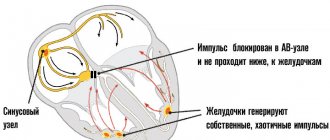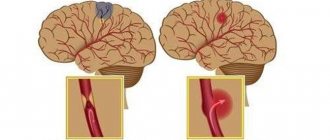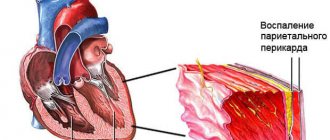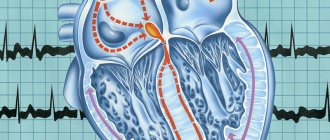Hemorrhagic shock (HS) is a critical condition of the body associated with acute blood loss, resulting in a crisis of macro- and microcirculation, a syndrome of multiple organ and multisystem failure. From a pathophysiological point of view, this is a crisis of microcirculation, its inability to ensure adequate tissue metabolism, satisfy the tissue need for oxygen, energy products, and remove toxic metabolic products.
The body of a healthy person can restore blood loss of up to 20% of the bcc (approximately 1000 ml) due to autohemodilution and redistribution of blood in the vascular bed. With blood loss of more than 20-25%, these mechanisms can eliminate the deficit of blood volume. With massive blood loss, persistent vasoconstriction remains the body’s leading “protective” reaction, and therefore normal or close to normal blood pressure is maintained, blood supply to the brain and heart is provided (centralization of blood circulation), but at the expense of weakening blood flow in the muscles of internal organs, including kidneys, lungs, liver.
Long-term stable vasoconstriction, as a protective reaction of the body at first, maintains blood pressure within certain limits for some time, and later, with the progression of shock and in the absence of adequate therapy, contributes to the consistent development of severe microcirculation disorders, the formation of “shock” organs and the development of acute renal failure and other pathological conditions.
The severity and speed of disorders during HS depends on the duration of arterial hypotension and the ascending state of organs and systems. With ascending hypovolemia, short-term hypoxia during labor leads to shock, as it is a trigger for impaired hemostasis.
General information
Hypovolemic shock is a pathological condition that develops under the influence of a decrease in the volume of circulating blood in the bloodstream or fluid deficiency (dehydration) in the body. As a result, stroke volume and the degree of filling of the ventricles of the heart decrease, which leads to the development of hypoxia , tissue perfusion and metabolic . Hypovolemic shock includes:
- Hemorrhagic shock, the development of which is based on acute pathological loss of blood (whole blood/plasma) in a volume exceeding 15-20% of the total bcc (circulating blood volume).
- Non-hemorrhagic shock, developing due to severe dehydration of the body caused by uncontrollable vomiting, diarrhea , and extensive burns.
Hypovolemic shock develops mainly with large losses of fluid from the body (with pathological loose stools, loss of fluid through sweat, uncontrollable vomiting, overheating of the body, in the form of clearly imperceptible losses). According to the mechanism of development, it is close to hemorrhagic shock, except that fluid in the body is lost not only from the vascular bloodstream, but also from the extravascular space (from the extracellular/intracellular space).
The most common occurrence in medical practice is hemorrhagic shock (HS), which is a specific response of the body to blood loss, expressed by a complex of changes with the development of hypotension , tissue hypoperfusion , small output syndrome , hemocoagulation , impaired permeability of the vascular wall and microcirculation, multisystem/multiple organ failure.
The triggering factor for HS is pathological acute blood loss, which develops when large blood vessels are damaged as a result of open/closed trauma, damage to internal organs, gastrointestinal bleeding, pathologies during pregnancy and childbirth.
Lethal outcome from bleeding occurs more often as a result of the development of acute cardiovascular failure and much less often due to the loss of blood of its functional properties (impaired oxygen-carbon dioxide metabolism, transfer of nutrients and metabolic products).
Two main factors play a role in the outcome of bleeding: the volume and rate of blood loss. It is generally accepted that an acute simultaneous loss of circulating blood in a short period of time in a volume of about 40% is incompatible with life. However, there are situations when patients lose a significant amount of blood due to chronic/recurrent bleeding, but the patient does not die. This is due to the fact that with minor one-time or chronic blood loss, the compensatory mechanisms existing in the human body quickly restore blood volume/circulation speed and vascular tone. That is, it is the speed of implementation of adaptive reactions that determines the possibility of preserving/maintaining vital functions.
There are several degrees of acute blood loss:
- I degree (BCC deficiency up to 15%). Clinical symptoms are practically absent, in rare cases - orthostatic tachycardia , hemoglobin more than 100 g/l, hematocrit 40% or higher.
- II degree (BCC deficiency 15-25%). Orthostatic hypotension, blood pressure decreased by 15 mm Hg. or more, orthostatic tachycardia, heart rate increased by more than 20/minute, hemoglobin level 80-100 g/l, hematocrit level 30-40%.
- III degree (BCC deficiency 25-35%). There are signs of peripheral dyscirculation (pronounced pallor of the skin, cold extremities to the touch), hypotension (systolic blood pressure 80-100 mm Hg), heart rate exceeds 100/minute, respiratory rate more than 25/minute), orthostatic collapse , decreased diuresis (less 20 ml/h), hemoglobin within 60-80 g/l, hematocrit - 20-25%.
- IV degree (BCC deficit more than 35%). There is impaired consciousness, hypotension (systolic blood pressure less than 80 mm Hg), tachycardia (heart rate 120/minute or more), respiratory rate more than 30/minute, anuria; hemoglobin is less than 60 g/l, hematocrit is less than 20%.
The degree of blood loss can be determined based on various direct and relative indicators. Direct methods include:
- Calometric method (weighing of spilled blood by colorimetry).
- Gravimetric method (radioisotope method, polyglucinol test, determination using dyes).
To indirect methods:
- Algover shock index (determined using a special table based on the ratio of pulse rate and systolic pressure).
Based on laboratory or clinical indicators, the most accessible of which are:
- Based on blood specific gravity, hemoglobin content and hematocrit.
- By changes in hemodynamic parameters (BP and heart rate).
The amount of blood loss during injuries can be determined approximately and by the location of the damage. It is generally accepted that the volume of blood loss from rib fractures is 100-150 ml; for a fracture of the humerus - at the level of 200-500 ml; tibia - from 350 to 600 ml; hips - from 800 to 1500 ml; pelvic bones within 1600-2000 ml.
Clinical picture
The following symptoms and signs are characteristic of hemorrhagic shock:
- general weakness;
- attacks of nausea with dry mouth;
- dizziness, darkening of the eyes, loss of consciousness;
- paleness of the skin to a gray tint;
- decreased temperature of the extremities;
- cold sweat;
- decreased production of normal amounts of urine;
- development of acute renal failure;
- increased shortness of breath, disturbance of breathing rhythm;
- the emergence of stable emotional arousal;
- cyanosis of the feet, hands, ears, lips and tip of the nose;
- increase in general swelling.
In general, the clinical manifestations of hemorrhagic shock in humans depend not only on the rate of blood loss, but also on the level of individual compensatory mechanisms, which directly depend on age, constitutional build, and associated aggravating factors, for example, heart and lung diseases.
Children and the elderly, pregnant women with gestosis, as well as people who are obese or have reduced immunity suffer more severely from other acute bleeding.
Pathogenesis
The main factors in the development of hemorrhagic shock include:
- Severe deficit of blood volume with the development of hypovolemia , which leads to a decrease in cardiac output.
- Decreased oxygen capacity of the blood (oxygen delivery to cells and reverse transport of carbon dioxide decreases. The process of delivery of nutrients and removal of metabolic products also suffers).
- Hemocoagulation disorders that cause disorders in the microvasculature - a sharp deterioration in the rheological properties of blood - increased viscosity (thickening), activation of the blood coagulation system, agglutination of blood cells, etc.
hypoxia occurs , often of a mixed type, capillarotrophic insufficiency, causing dysfunction of organs/tissues and disruption of the body's vital functions. Against the background of disruption of systemic hemodynamics and a decrease in the intensity of biological oxidation in cells, adaptation mechanisms are turned on (activated) aimed at maintaining the vital functions of the body.
Adaptation mechanisms primarily include vasoconstriction (vasoconstriction), which occurs due to activation of the sympathetic part of neuroregulation (release of adrenaline , norepinephrine ) and the action of humoral hormonal factors (glucocorticoids, antidiuretic hormone, ACTT, etc.).
Vasospasm helps to reduce the capacity of the vascular bloodstream and centralize the circulatory process, which is manifested by a decrease in the volumetric velocity of blood flow in the liver, kidneys, intestines and vessels of the lower/upper extremities and creates preconditions for further disruption of the function of these systems and organs. At the same time, the blood supply to the brain, heart, lungs and muscles involved in the act of breathing continues to remain at a sufficient level and is the last thing to be disrupted.
This mechanism, without pronounced activation of other compensation mechanisms in a healthy person, is capable of independently neutralizing the loss of about 10–15% of the bcc.
The development of severe ischemia of a large tissue mass contributes to the accumulation of under-oxidized products in the body, disturbances in the energy supply system and the development of anaerobic metabolism. adaptive response to progressive metabolic acidosis , since they contribute to more complete utilization of oxygen by various tissues.
Relatively slowly developing adaptive reactions include fluid redistribution (its movement into the vascular sectors from the interstitial space). However, this mechanism is realized only in cases of slowly occurring minor bleeding. Less effective adaptive responses include increased heart rate (HR) and tachypnea .
Developing cardiac/respiratory failure is leading in the pathogenesis of acute blood loss. Volumetric bleeding leads to decentralization of the systemic circulation, an extreme decrease in the oxygen capacity of the blood and cardiac output, irreversible metabolic disorders, “shock” organ damage with the development of multiple organ failure and death.
In the pathogenesis of hypovolemic shock, it is necessary to take into account the role of the developing imbalance of electrolytes, in particular, the concentration of sodium ions in the vascular bed and extracellular space. In accordance with their concentration in the blood plasma, isotonic type of dehydration (at normal concentration), hypertonic (increased concentration) and hypotonic (decreased concentration) type of dehydration are distinguished. Moreover, each of these types of dehydration is accompanied by specific shifts in plasma osmolarity, as well as extracellular fluid, which has a significant impact on the nature of hemocirculation, the state of vascular tone and cell functioning. And this is important to consider when choosing treatment regimens.
Disseminated intravascular coagulation syndrome
The most dangerous complication of hypovolemic shock is disseminated intravascular coagulation or DIC. It is manifested by a violation of macrocirculation, as a result of which microcirculation stops, which leads to the death of vital organs. The heart, lungs and brain are the first to be affected. Then soft tissues atrophy and ischemia appears. DIC syndrome is a condition when, upon contact with oxygen, blood begins to clot in the vessels. Because of this, blood clots form, which disrupt the circulation process.
- HEMORRHAGIC SHOCK IN OBSTETRICS – Med24info.com
Classification of hemorrhagic shock
The classification of hemorrhagic shock is based on the stage of development of the pathological process, according to which there are 4 degrees of hemorrhagic shock:
- First degree shock (compensated reversible shock). It is caused by a small amount of blood loss, which is quickly compensated by functional changes in the work of cardiovascular activity.
- Shock of the second degree (subcompensated). Developing pathological changes are not fully compensated.
- Third degree shock (decompensated reversible shock). Disturbances are expressed in various organs and systems.
- Fourth degree shock (irreversible shock). It is characterized by extreme depression of vital functions and the development of irreversible multiple organ failure.
Causes
The most common causes of hemorrhagic shock are:
- Injuries - damage (fractures) to large bones, injuries to internal organs/soft tissues with damage to large vessels, blunt trauma with rupture of parenchymal organs (liver or spleen), rupture of an aneurysm of large vessels.
- Diseases that can cause blood loss are acute gastric/duodenal ulcers , cirrhosis of the liver with esophageal varices, infarction/ lung gangrene , Mallory-Weiss syndrome, malignant tumors of the chest and gastrointestinal tract, hemorrhagic pancreatitis and other diseases with a high risk of rupture of blood vessels vessels.
- Obstetric bleeding that occurs when a tube ruptures/ectopic pregnancy, abruption/ placenta previa , multiple pregnancy, cesarean section, complications during childbirth.
Symptoms
The clinical picture of hemorrhagic shock develops in accordance with its stages. Clinically, signs of blood loss come to the fore. At the stage of compensated hemorrhagic shock, consciousness, as a rule, does not suffer, the patient notes weakness, may be somewhat agitated or calm, the skin is pale, and the extremities are cold to the touch.
The most important symptom at this stage is the desolation of the subcutaneous venous vessels in the arms, which decrease in volume and become thread-like. The pulse is weak and rapid. Blood pressure is usually normal, sometimes elevated. Peripheral compensatory vasoconstriction is caused by overproduction of catecholamines and occurs almost immediately after blood loss. Against this background, at the same time the patient develops oliguria . At the same time, the amount of urine excreted may be reduced by half or even more. Central venous pressure decreases sharply, which is due to a decrease in venous return. In compensated shock, acidosis is often absent or local in nature and mildly expressed.
At the stage of reversible decompensated shock, the signs of circulatory disorders continue to deepen. In the clinical picture, which is characterized by signs of the compensated stage of shock (hypovolemia, pallor, profuse cold and sticky sweat, tachycardia, oliguria), the main cardinal symptom is hypotension , which indicates a disorder in the circulatory compensation mechanism. It is in the stage of decompensation that organ circulatory disorders (in the intestines, liver, kidneys, heart, brain) begin. Oliguria, which in the compensation stage develops as a result of compensatory functions, at this stage occurs on the basis of a decrease in hydrostatic blood pressure and renal blood flow disorders.
At this stage, the classic clinical picture of shock appears: acrocyanosis and coldness of the extremities, increased tachycardia and the appearance breath , dullness of heart sounds, which indicates a deterioration in myocardial contractility. In a number of cases, there is a loss of individual or a whole group of pulse impulses in the peripheral arteries and the disappearance of heart sounds during deep inspiration, which indicates an extremely low venous return.
The patient is inhibited or in a state of prostration. Shortness of breath and anuria develop . DIC syndrome is diagnosed. Against the background of the most pronounced vasoconstriction of peripheral vessels, direct discharge of arterial blood into the venous system occurs through opening arteriovenous shunts, which allows increasing oxygen saturation of the venous blood. At this stage, acidosis is pronounced, which is a consequence of increasing tissue hypoxia .
The stage of irreversible shock is not qualitatively different from decompensated shock, but is a stage of even more pronounced and profound disorders. The development of a state of irreversibility is manifested by a matter of time and is determined by the accumulation of toxic substances, the death of cellular structures, and the appearance of signs of multiple organ failure. As a rule, at this stage there is no consciousness, the pulse in the peripheral vessels is practically not determined, blood pressure (systolic) is at the level of 60 mm Hg. Art. and lower, difficult to determine, heart rate at 140/min., breathing is weakened, rhythm is disturbed, anuria. There is no effect from infusion-transfusion therapy. The duration of this stage is 12-15 hours and ends in death.
Urgent measures
- It is necessary, first of all, to stop arterial bleeding by pressing the artery to the bone above the site of injury, applying an arterial tourniquet or twisting it above the site of injury. In this case, you should record the time when the tourniquet was applied.
- Assess the state of vitality of the body (determine the presence and nature of the pulse over the peripheral and central arteries, the degree of depression of consciousness, airway patency, the effectiveness of external respiration function).
- Ensure the correct position of the victim's body. In an unconscious state, he should be turned on his side, his head thrown back and the upper half of his body slightly lowered. A separate position is required for patients with fractures of the spine (on a hard surface) and pelvic bones (with legs bent at the joints and spread apart). It is contraindicated to throw the head back in patients with a cervical spine injury!
- Provide immobilization of injured limbs with standard splints or available material.
- Apply a bandage to the wound. In case of venous or capillary bleeding, a compressive bandage has a hemostatic effect. For open pneumothorax, an adhesive bandage seals the chest.
- Anesthetize the patient. Narcotic and non-narcotic analgesics are used (1% promedol solution, 50% analgin solution).
In patients with decompensated shock, narcotic analgesics can suppress the respiratory center. In addition, excluding the stimulating influence of pain reduces the activity of the adrenal glands; in patients with BCC deficiency, this can lead to threatening hypotension. The high probability of these complications requires continuous monitoring of patients. If it is impossible to provide such supervision (for example, in case of mass arrival of victims, their transportation), for the purpose of pain relief, it is advisable to use a medium for non-inhalation anesthesia - ketamine (2-3 ml of 5% solution, administered intramuscularly). It exhibits an analgesic effect, stabilizes blood pressure and does not suppress the respiratory center. To prevent the unwanted hallucinatory effects of ketamine, it is advisable to combine it with the administration of 1-2 ml of a 0.5% sibazon solution.
10-20 ml of 0.5% novocaine solution is injected into the fracture sites. As part of a specialized team, a nurse performs venipuncture and catheterizes peripheral vessels, assists the doctor with catheterization of arteries and main veins, prepares systems for intravenous infusions, measures arterial and central venous pressure, records an electrocardiogram, provides oxygen therapy and artificial ventilation to the victim, etc.
Tests and diagnostics
The diagnosis of hemorrhagic shock is established based on examination of the patient (presence of fractures, external bleeding) and clinical symptoms reflecting the adequacy of hemodynamics (color and temperature of the skin, changes in pulse and blood pressure, calculation of the shock index, determination of hourly diuresis) and laboratory test data, including: determination CVP, hematocrit , blood CBS (indicators of acid-base status).
Establishing the fact of blood loss due to external bleeding does not present any difficulties. But in its absence and suspicion of internal bleeding, it is necessary to take into account a number of indirect signs: in case of pulmonary hemorrhage - hemoptysis; for stomach and duodenal ulcers or intestinal pathology - vomiting “coffee grounds” and/or melena; in case of damage to parenchymal organs - tension of the abdominal wall and dullness of percussion sound in the sloping parts of the abdomen, etc. If necessary, instrumental studies are prescribed: ultrasound, radiography, MRI, laparoscopy, consultations with various specialists are prescribed.
It should be borne in mind that the assessment of the volume of blood loss is approximate and subjective, and if it is assessed inadequately, you can miss the permissible waiting interval and find yourself faced with the fact that a picture of shock has already developed.
During pregnancy
Hemorrhagic shock in obstetrics, which occurs during pregnancy, during labor, as well as in the early/late afterbirth period, is one of the significant causes in the structure of maternal mortality, accounting for about 20–25%. The rate of obstetric hemorrhage relative to the total number of births varies between 5-8%.
The specifics of bleeding in obstetrics are:
- The suddenness of their appearance and massiveness.
- High risk of fetal death, which necessitates urgent delivery until stable stabilization of hemodynamic parameters and completion of infusion-transfusion therapy in full.
- Combination with pronounced pain syndrome.
- Rapid depletion of compensatory and protective mechanisms. At the same time, the risk is especially high in pregnant women with late gestosis and in women with complicated labor.
The permissible blood loss during childbirth during its normal course should not exceed 250-300 ml (approximately 0.5% of a woman’s body weight). This amount of blood loss refers to the “physiological norm” and does not negatively affect the condition of the woman in labor. The main causes of acute pathological blood loss during pregnancy with the development of hemorrhagic shock are: ectopic pregnancy , placental abruption/previa, multiple pregnancy, complications during childbirth, cesarean section, uterine rupture.
Features of hemorrhagic shock in obstetric pathology include: its frequent development against the background of a severe form of gestosis in pregnant women, the rapid development of hypovolemia , disseminated intravascular coagulation syndrome, arterial hypotension , and hypochromic anemia .
In case of HS, which developed in the early postpartum period against the background of hypotonic bleeding, a short period of unstable compensation is characteristic, after which irreversible changes quickly develop (persistent hemodynamic disturbances, DIC syndrome with profuse bleeding, respiratory failure and impaired blood coagulation factors with activation of fibrinolysis).
Determining the amount of blood loss
There are two ways to determine the extent of deterioration in the patient’s condition and the amount of blood loss.
According to Negovsky (based on the total body weight of the patient):
- I Art. – 0.5 l, 7 ml/kg;
- II Art. – 0.8 – 1.2 l, 11 – 17 ml/kg;
- Stage III – 1.5 – 2 l, 21.4 – 28.6 ml/kg;
- IV Art. – from 2.5 l.
List of sources
- Bratus V.D., Sherman D.M. Hemorrhagic shock, pathophysiology and clinical aspects. Kyiv: Nauk. Dumka. 1989.
- Gakaev D. A. Pathophysiological changes in the body during acute blood loss [Text] // Medicine and healthcare: materials of the IV International. scientific conf. (Kazan, May 2021). - Kazan: Buk, 2016. - pp. 37-40.
- Vorobyov A.I., Gorodetsky V.M., Shulutko E.M., Vasiliev S.A. Acute massive blood loss. M.: GEOTAR-MED, 2001.
- Bryusov P.G. Emergency infusion-transfusion therapy for massive blood loss / P.G. Bryusov // Hematology and transfusiology. –1991. – No. 2. – P. 8-13.
- Stukanov M.M. Comparative assessment of infusion therapy options in patients with hemorrhagic shock / M.M. Stukanov et al. //Anesthesiology and resuscitation. – 2011. – No. 2. – P. 27-30.
Possible consequences
It is difficult to say precisely about the development of specific consequences after significant blood loss. They depend on the severity of the bleeding, the amount of lost blood volume and the physiology of the patient himself. Some people experience a disruption in the functioning of the neural system, others experience only weakness, although there are also cases of instant loss of consciousness. Possible consequences include:
- Kidney failure, damage to the lung lining, or partial brain atrophy. Such consequences can occur even with timely infusion therapy.
- After severe shock of stages 2-4, in most cases, long-term rehabilitation is necessary to restore normal functioning of the brain, kidneys, lungs and liver. It takes 2-4 days to produce new blood.
- With postpartum shock, loss of reproductive function may occur due to removal of the fallopian tubes or uterus.










